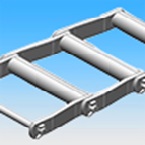Large size conveyor chain
Product Info Large size conveyor chain
Large size conveyor chains are chains with a wide operational range: they can transport in any direction in any combination freely - horizontal, vertical, inclined, etc., do not require special materials for temperatures up to about 200°C, use heat-resistant steel for higher temperatures, and have corrosion and chemical resistant specifications against water and chemicals.
It can carry almost any materials, from powders such as pulverized coal and cement to granular products such as wheat and soybeans, lumps such as ores and rocks, and products weighing several tones each, with few restrictions on what can be transported.
Contents
Large size conveyor chain Related information
Construction

Screw Lock Link

Connecting link for safe and quick operation.
Note) The pin length is longer due to the nut method. Please make sure that there is no interference with the device.
※Total length tolerance for large size conveyor chain is +0.25%.
■Slip fit
When the shafts (pins and bushes) and holes are fitted together, there is always a loose fit.
This is a fit where the range of hole tolerance is larger than the range of shaft (pin or bushing) tolerance.
■Press fit
When the shafts (pins and bushes) and holes are fitted together, there is always an interference fit.
This is a fit where the range of hole tolerance is smaller than the range of shaft (pin or bush) tolerance.
 See more about components and their roles
See more about components and their roles
| 1.Pin (CP) | 2.Bush (B) | |
|---|---|---|
| The most important role of the pin is connecting the inner link to the outer link. Along with the plate, it receives chain tension along the direction of travel while receiving vertical reactive forces from the conveyed items. The outer diameter of the pin suffers wear from sliding against the bush inner diameter when the chain articulates. The pin is an essential strength bearing part and requires high wear resistance. | The bush is a strength bearing part, receiving tension from the chain during sprocket engagement, but its main role is as a bearing part. The outer diameter of the bush suffers wear from sliding against the roller inner diameter during roller rotation, while the bush inner diameter suffers wear from sliding against the outer diameter of the pin when the chain articulates. Bush inner diameter wear is directly expressible as pitch elongation. | |
| 3.Roller (R-R, F-R, S-R, M-R, N-R) | 4.Plate (PLP-A, PLP-B, BLP) | |
| Forms a slip fit with the bush. Rotates when engaging with the sprocket, while alleviating the shock and wear from the teeth. Rotation also lowers running resistance. | The plate mainly receives the tensile load along the chain's direction of travel while receiving vertical reactive forces while supporting the conveyed item. The outer plate and inner plate slide against each other during chain articulation, as well as against the sides of the sprocket teeth during sprocket engagement. Outer plate holes are either round or flat. | |
| 5.T-pin (T-PIN) | 6.Attachments | |
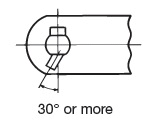 |
After the outer plate is press-fitted to the pin, A T-pin is inserted and bent to prevent the pin from falling out.Bend 30º or more, or so that the end of the T-pin does not exceed the height of the plate. | For attaching items to the chain. See "Attachment types" below for the types of attachments. |
■Basic 3 dimensions of chain
The pitch, roller diameter, and inner width of the inner link are considered the basic three dimensions of a roller chain. When these dimensions are identical, a roller chain and sprocket are dimensionally compatible.
 See more about attachment types
See more about attachment types
Attachments are parts for attaching conveying jigs to chains. They can be assembled at any desired spacing.
Standard attachment
Standard attachments are both economical and versatile.
A attachments
A attachments are bent on one side of the chain.
They are referred to as A1, A2, or A3, depending on the number of bolt holes.
A1 attachment

A2 attachments

A3 attachment
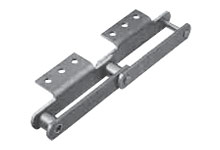
K attachments
K attachments are bent on both sides of the chain.
They are referred to as K1, K2, or K3, depending on the number of bolt holes.
K1 attachment

K2 attachment
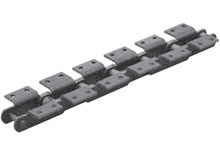
K3 attachment
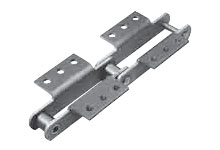
GA attachment
GA attachments have a hole in the link plates on one side.
Referred to as GA2 or GA4, depending on the number of bolts holes.
GA2 attachment
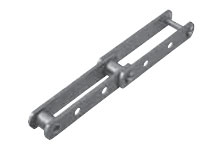
GA4 attachments
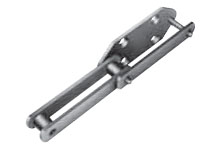
Special attachments
Special attachments for various applications.
Deep link

Top roller

Outboard roller

Flow
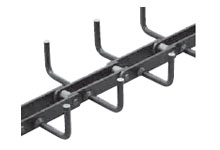
Integrated Attachment Chain
Wide variety of Integrated Attachments.
SA attachments
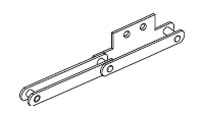
Straight attachment on one side
SK attachments

Straight attachments on both sides
CA2 attachments

Used to attach a net or slat with no spacing
AA3 attachments

Strong type, attachment fits between the plates.
AR2 attachments

A attachment with increased flexural rigidity
(w/reinforcing ribs )
MG2 attachments
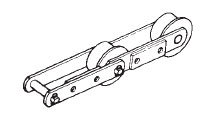
Allows for one mounted jig to be used
AS2 attachments
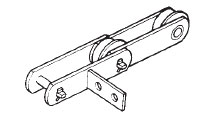
For scrapers or flights
AF2 attachments
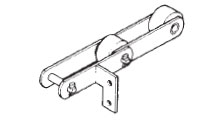
For deep scrapers or flights
WSA0 attachments
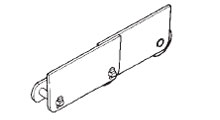
Prevents conveyed items from spilling
With extended pins
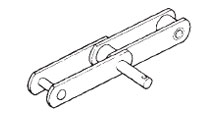
Objects can be attached to the pin end
(Model : EN)
Stay Pin

Item can be directly laid on stay pin, or mesh, etc. can be attached
(Model : TN)
Top plates

Prevents damage to conveyed items
(Model : TP)
Trolley rollers
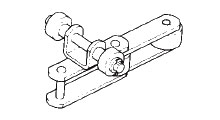
Used in long distance, horizontal applications
(Model : TRO)
Outboard rollers
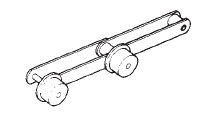
Provides support for heavy loads
(Model : RO)
Guide shoes

Prevents lateral movement
(Model : GS)
Guide Roller

Used in horizontal applications
(Model : GR)
Fixed dogs
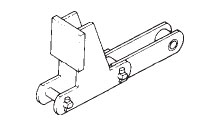
Conveys by pushing
(Model : KD)
Dog rollers

Conveys round items by pushing
(Model : RD)
Tilting dogs

Can accumulate items on top of the conveyor
(Model : CD)
Roller tilting dogs
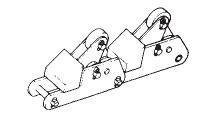
Can accumulate round items
(Model : RCD)
Ducking dogs

Conveyed item will remain in fixed position
(Model : DD)
Roller types
Large size conveyor chains come with three basic roller types, depending on the application.
| Basic Roller Types for Large Size Conveyor Chain | ||
|---|---|---|
| R-roller | F-roller | S,M,N-roller |
 |
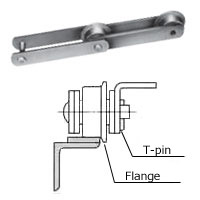 |
 |
|
|
Works to alleviate shock and wear when engaging the sprocket.
|
 See more about roller guide methods
See more about roller guide methods
The following are examples of methods for guiding rollers on the drive and return sides for smooth large size conveyor chain operation.
Guide Methods
| R roller (S roller) chains | F-roller chain | Outboard Roller Chains | |
|---|---|---|---|
| Drive side |  |
 |
 |
| Return Way | 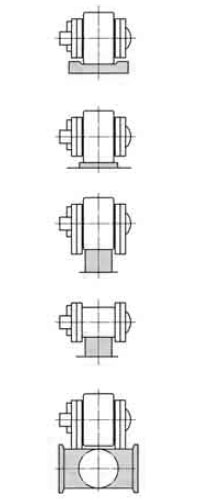 |
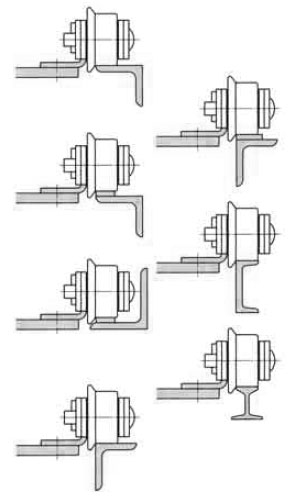 |
 |
Safety precautions
Never weld additional parts onto an assembled chain. Doing so may cause chain kinking or twisting due to plate deformation, further reducing part hardness and leading to embrittlement fracture from the welding heat.
Large size conveyor chain
- General-purpose・Heavy duty
- Environment resistant
- Bearing roller
conveyor chain - Cement Conveyance
- Steel Facilities
- Biomass
- Waste Disposal Facilities
- Food Industry
- Water Treatment Facilities
- Automotive Industry
- Special
- Application devices
Accessories
Special Conveyor Chain (Biomass Power Generation)
Drag chain for conveying wood chips in biomass power generation facility.
In addition to the following, various conveyor chains are available for harsh applications in biomass power generation facilities. Please click here for the selection guide.
Drag chains WD Type
Model No. WD□□□~
This exclusive chain is specially designed for directly pushing conveyed objects with a chain.
- ・Drag chains are solid steel chains with plates and bushes welded together.
- ・Leading face of bush is flat so it can push conveyed material, while trailing face of bush is round so it can smoothly engage with a sprocket.
- ・Both ends of a cotter pin are secured with a T-pin for a simple construction.
- ・Heavy Duty specs with a higher tensile strength and corrosion resistant specs also available.
- ・Unique attachments also available (MTO item).
Size
WD480(WD112, 120), WD110
Attachment Types
Scrapers :SCR
Guide Shoes :GS
※Please contact us.



